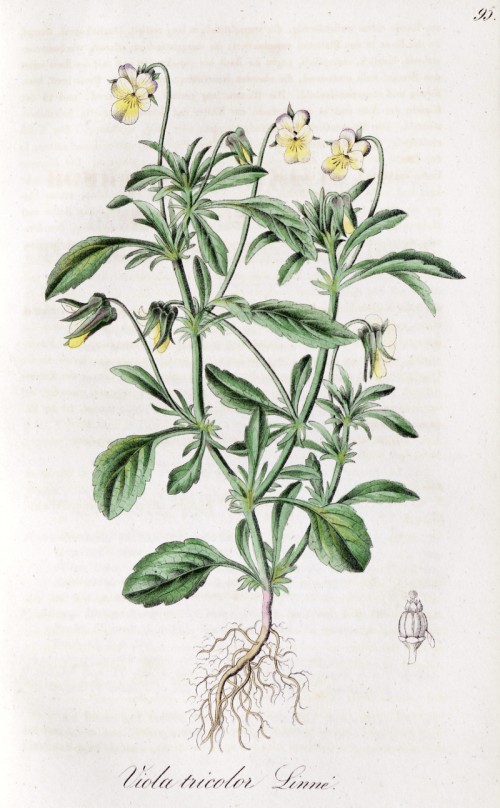Viola tricolor L. - Violaceae - European wild pansy, field pansy, hearts ease, love in idleness, Johny jump up, Feldstiefmütterchen, Wildes Stiefmütterchen
Annual herb, up to 40cm high, native to Europe, West Sibiria, North Africa; basal leaves narrowly ovate or lanceolate, long petiolate, stipules large, leaflike, deeply pinnatifid, 1-4 cm; petioles of upper leaves longer, those of lower leaves shorter; cauline leaves ovate, oblong-orbicular, or oblong-lanceolate, base rounded, margin remotely crenate; flowers solitary in leaf axils, upper petals deep purple-violet, lateral petals and anterior one 3-colored, purple-striate.
http://www.efloras.org/florataxon.aspx?flora_id=2&taxon_id=200014437
The dried aboveground parts (Violae tricoloris herba) are used in supportive treatment of various skinconditions. „Nowadays, the main use of the herb is to treat eczema, impetigo, pruritus and acne. Traditionally, it is an expectorant, diuretic and anti-inflammatory. It is regarded against troat infections and is sometimes used as antitussive, cholagogue, antirheumatic and tonic… The triterpenes, flavanoids and methyl salicylate exhibit anti-inflammatory and secretolytic effects. These substances would plausibly explain the use of Viola tricolor as an expectorant and antiphlogistic remedy to treat catarrhs and skin inflammations.“
[Medicinal Plants of the World. Ben-Erik Van Wyk and Michael Wink, Pretoria 2004, 341]
Whereas the essential oil obtained from fresh aerial parts of V. tricolor (35 compounds, 97.7% identified) contained bisabolone oxide (43.2%), trans-β-farnesene (4.0%), bisabolol oxide A and B (7.7% and 2.2%) as main components, these substances were absent in dried material.
The main volatile components identified in essential oil from dried aerial parts (24 compounds representing 60.5%) were hexahydrofarnesyl acetone (4.0%), methyl salicylate (1.2%), and β-ionone (1.0%).
[Composition of essential oils of Viola tricolor and V. arvensis from Romania., Anca, T., Philippe, V., Ilioara, O., Mircea, T., Chemistry of natural compounds, 45(1), 2009, 91-92]
„… V. tricolor contains a suite of cyclotides, seven of which are new ones, i.e. vitri B–F, varv Hm, and He. Several cyclotides purified from V. tricolor exhibit potent cytotoxicity. Although hydrophobicity has previously been shown to correlate with hemolytic activity, the larger number of peptides tested in the current study suggests that overall hydrophobicity alone is not a predictor of hemolytic activity. The distribution of highly hydrophobic residues on the surface also appears to play a role in determining cytotoxicity. Overall, the trends in hemolytic and cytotoxic activity reported here have highlighted the complexity of the activity of cyclotides, which is most likely related to binding to membranes.“
[Isolation and characterization of cytotoxic cyclotides from Viola tricolor., Tang, J., Wang, C.K., Pan, X., Yan, H., Zeng, G., Xu, W., Tan, N., Peptides, 31(8), 2010, 1434-1440]
„The aqueous Viola extract inhibited proliferation of activated lymphocytes by reducing IL-2 cytokine secretion without affecting IL-2 receptor expression. Similarly, effector functions were affected as indicated by the reduction of IFN-γ and TNF-α production; degranulation capacity of activated lymphocytes remained unaffected. Bioassay-guided fractionation and phytochemical analysis of the extract led to identification of circular plant peptides, so called cyclotides, as bioactive components… The findings provide a rationale for use of herbal Viola preparations in the therapy of disorders related to an overactive immune system. However, further studies to evaluate its clinical potency and potential risks have to be performed.“
[Immunosuppressive activity of an aqueous Viola tricolor herbal extract., Hellinger, R., Koehbach, J., Fedchuk, H., Sauer, B., Huber, R., Gruber, C.W., Gründemann, C., Journal of ethnopharmacology, 151(1), 2014, 299-306]

Dietrich, A.G., Flora regni borussici, vol. 2: t. 95 (1834)
http://plantgenera.org/species.php?id_species=1065936